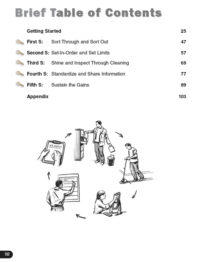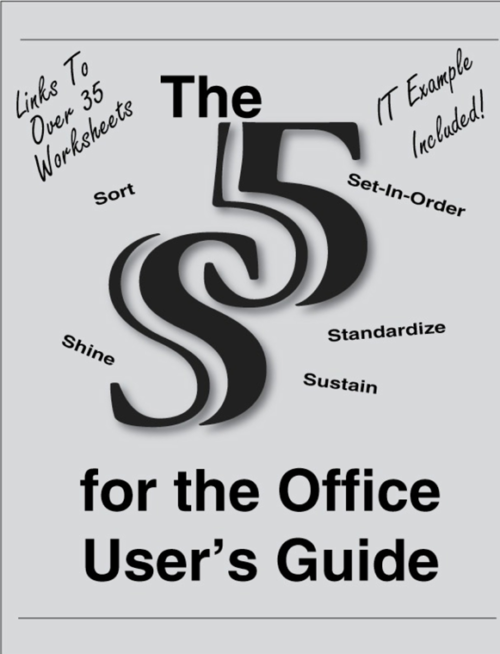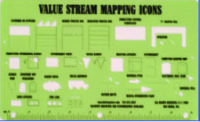The 5S for the Office User's Guide provides an organization with the forms, worksheets, and checklists necessary to ensure a 5S project is well-planned from the start - as well as ensuring the program is sustained over time. This how-to guide should be used as it is titled - as a "Guide". The information contained in this workbook should supplement, support, and enhance, etc. current materials that an organization may currently be using.
Throughout The 5S for the Office User’s Guide there will be various quotations, performance points, references to PC file storage (the IT case study in the appendix) etc. to further invoke the overall need to do 5S in all types of administrative settings. As organizations automate more administrative functions (i.e., becoming more paperless) then there must exist that same type of organization and standardization for a physical file system as well as the computer file system. It is the focus of this User’s Guide to have the 5S principles apply to both the physical desktop (paperwork, desk layout, drawer organization, etc.) and the PC desktop (folders, files, emails, shortcuts, etc.).
No workbook or guide can take the place of a person’s enthusiasm and passion to improve. However, what this guide can do is provide a good, solid foundation on what is required to effectively implement 5S in administrative settings while also spearheading efforts to bring those principles to the PC.
-
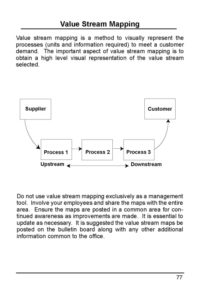
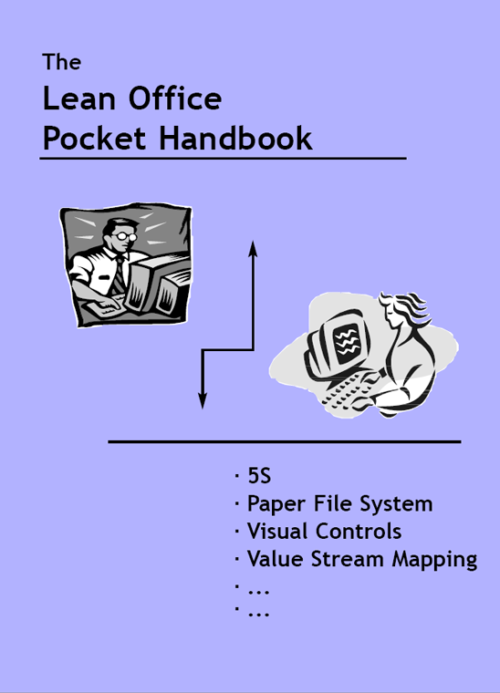 By: Roger Kremer
By: Roger Kremer
The Lean Office Pocket Handbookis a quick-reference guide covering the terms, concepts, benefits and techniques for the application of Lean in administrative areas of all industry types. It is easy to follow, simple in its concepts, and, above all, practical to use. The tools of 5S, continuous flow, office layout, value stream mapping, process mapping, problem solving, kanbanning office supplies, kaizen, plus numerous other Lean tools are defined in terms that relate to the administrative environment. -
Sale!
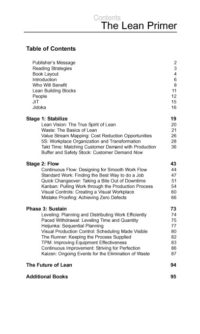
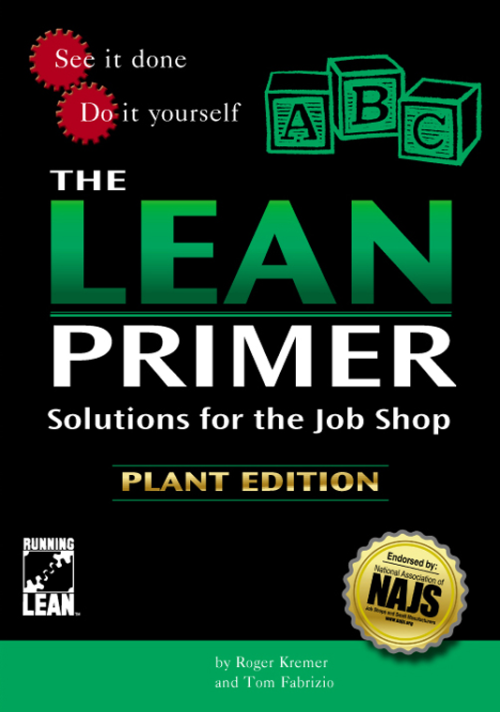 By: Roger Kremer and Tom Fabrizio The Lean Primer will allow you to train the organization to understand how critical the implementation of Lean principles and processes are to your short and long term success. It will provide the various reasons why an organization must go Lean, as well as detailing what Lean is. Lean will be explained in the terms of Stabilize, Flow, and Sustain with reference to the following topics of lean vision, waste, value stream mapping, 5S, takt time, buffer and safety stock, continuous flow, standard work, quick changeover, kanban, visual controls, mistake-proofing, leveling, paced withdrawal, visual production control, runners, TPM, and kaizen. Each of these tools will also be explained with digital photos from world-class shops from across the US that shared their best practices.
By: Roger Kremer and Tom Fabrizio The Lean Primer will allow you to train the organization to understand how critical the implementation of Lean principles and processes are to your short and long term success. It will provide the various reasons why an organization must go Lean, as well as detailing what Lean is. Lean will be explained in the terms of Stabilize, Flow, and Sustain with reference to the following topics of lean vision, waste, value stream mapping, 5S, takt time, buffer and safety stock, continuous flow, standard work, quick changeover, kanban, visual controls, mistake-proofing, leveling, paced withdrawal, visual production control, runners, TPM, and kaizen. Each of these tools will also be explained with digital photos from world-class shops from across the US that shared their best practices. -
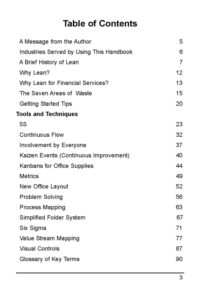
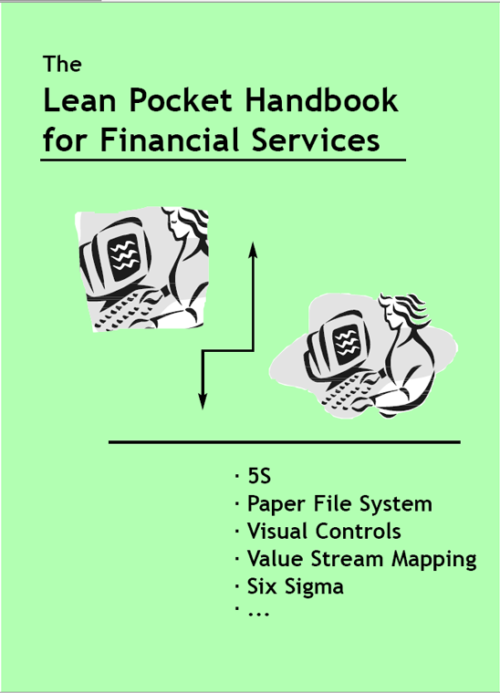 By: David M. TappingThe Lean Pocket Handbook for Financial Services is a quick, ready-to-use, reference allowing employee's in the financial, insurance, and banking industry to learn, understand, and apply Lean (continuous improvement) tools. The book describes the basic thirteen Lean tools (5S, continuous flow, standard work, paper file system, Six Sigma, etc.) that have proven successful in financial service applications. Lean is a business improvement system based on the powerful concepts documented by the world-class Toyota Motor Corporation. Lean is a process to eliminate waste. For these financial service industries to obtain their share of the 21st century investment and banking business, costs must be contained and waste eliminated. If this does not occur through the use of Lean and Six Sigma, your ATM card will be drawing from the Chekiang First Bank Ltd., Beijing, China.
By: David M. TappingThe Lean Pocket Handbook for Financial Services is a quick, ready-to-use, reference allowing employee's in the financial, insurance, and banking industry to learn, understand, and apply Lean (continuous improvement) tools. The book describes the basic thirteen Lean tools (5S, continuous flow, standard work, paper file system, Six Sigma, etc.) that have proven successful in financial service applications. Lean is a business improvement system based on the powerful concepts documented by the world-class Toyota Motor Corporation. Lean is a process to eliminate waste. For these financial service industries to obtain their share of the 21st century investment and banking business, costs must be contained and waste eliminated. If this does not occur through the use of Lean and Six Sigma, your ATM card will be drawing from the Chekiang First Bank Ltd., Beijing, China. -
Sale!
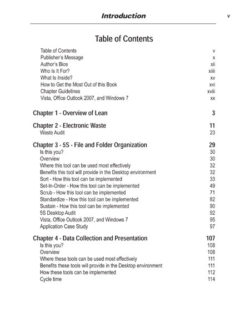
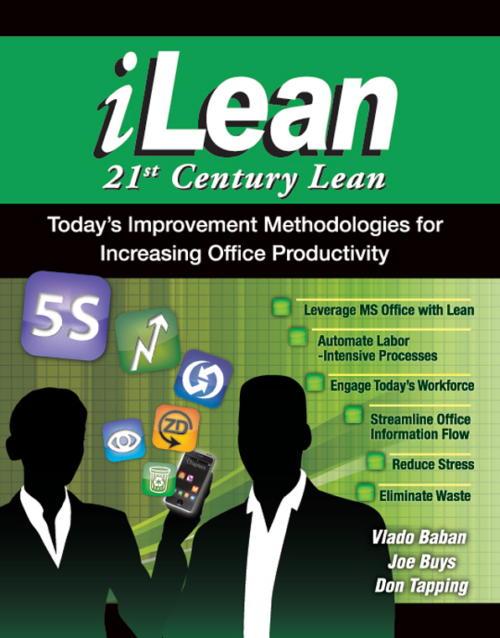 By: Vlado Baban, Joe Buys, and Don Tapping
By: Vlado Baban, Joe Buys, and Don Tapping
iLean's content will provide actual case studies, application examples, and working macros that have proven successful in improving information flow in all types of environments. iLean was arranged in a format that should provide you with enough detailed guidance (step-by-step instructions) to apply a similar-type Lean practice to your work process. Starting with Chapter 3, each chapter begins with a section titled Is this you? which was specifically designed to assist you in determining if that chapter has immediate relevancy to your current work challenges. Subsequently, it is suggested that a formal standard improvement methodology, Six Sigma's Design-Measure-Analyze-Improve-Control (D-M-A-I-C), Edward Deming's Plan-Do-Check-Act (PDCA) or some other similar methodology be used if a formal structure is required and/or more statistical analysis needs is required. However, many of the concepts and tools presented throughout this book can be implemented by an individual worker and, therefore, will not require a formal process (other than good project management skills). Microsoft s Office suite of products of Word, Excel, and Outlook, as well as Open Source applications of vTiger, Google Docs, and Huddle, are referenced throughout this book to provide an overall understanding of how Lean can be used to move information faster and more accurately than ever before. In doing so, you will be able to reduce inter-office dependencies, delays, and errors that may be present in your current business processes. -
Sale!
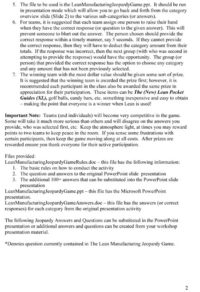
 The Lean Manufacturing Jeopardy Game is a highly-engaging game to reinforce Lean concepts presented throughout a training session or workshop. This activity is typically conducted at the end of a training session. Lean Jeopardy allows for the group to be energized with the information that had been presented, while at the same time having fun in a competitive manner. The Lean Manufacturing Jeopardy Game has four categories, What is it?, Why use it?, Where use it?, and Picture this? with 5 answers for each category. There is also an additional 100 answers provided in a Microsoft Word file from which you can cut and paste into the PowerPoint file for newer versions as you see fit. The new questions are referenced from The New Lean Pocket Guide (XL).
The Lean Manufacturing Jeopardy Game is a highly-engaging game to reinforce Lean concepts presented throughout a training session or workshop. This activity is typically conducted at the end of a training session. Lean Jeopardy allows for the group to be energized with the information that had been presented, while at the same time having fun in a competitive manner. The Lean Manufacturing Jeopardy Game has four categories, What is it?, Why use it?, Where use it?, and Picture this? with 5 answers for each category. There is also an additional 100 answers provided in a Microsoft Word file from which you can cut and paste into the PowerPoint file for newer versions as you see fit. The new questions are referenced from The New Lean Pocket Guide (XL). -
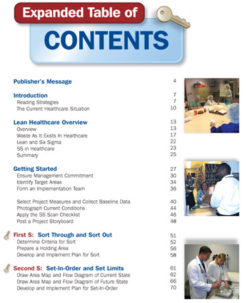
 By: Debra Hadfield (RN, BSN, MSN), Shelagh Holmes (RN), Tom Fabrizio, Roger Kremer, and Don Tapping
By: Debra Hadfield (RN, BSN, MSN), Shelagh Holmes (RN), Tom Fabrizio, Roger Kremer, and Don Tapping
Note: A Dropbox file link will be provided after purchase and the PDF can be used throughout your organization at no additional charge! This book is the first in the industry to offer real solutions and practical advice for improving patient and non-patient care processes, as well as reducing costs. Included in the book are over 20 forms, worksheets, and guidelines for you to use as a workbook as you implement your 5S portion of a Lean or Six Sigma project. Key learning features of this workbook include: 40+ digital photos demonstrating Lean and 5S projects, identification of who should be doing what part of the 5S activity, detailed procedures ensuring each 5S step is done thoroughly, started tips providing valuable insight from Lean Sensei, and quotes from various leaders throughout the world. -
Sale!
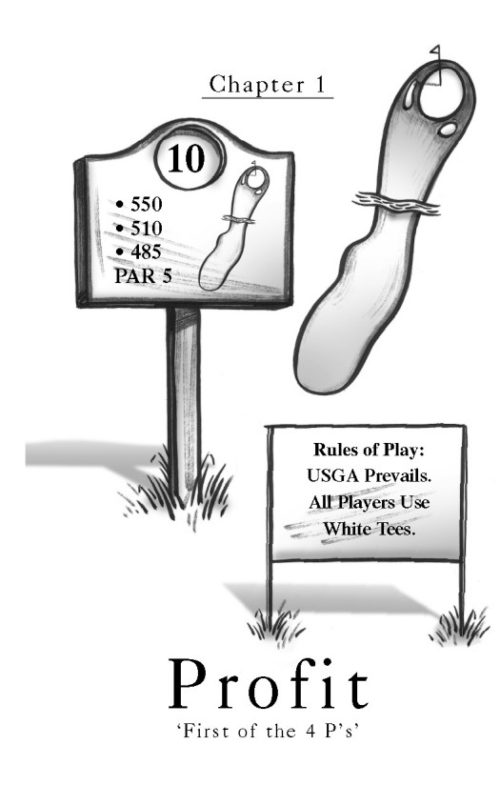
 By: Don Tapping and John West
By: Don Tapping and John West
Who Hollered Fore? creates an awareness of the evils of variation – along with the realization of what that costs an organization in time and money. This book will assist in creating a common language and basic Lean theme throughout your organization. Through the story of John, Laura, and the Bartlett’s, as they participate in a charity golf event, the conversation about Lean and golf become intertwined. And finally they discover the secret to it all! About Who Hollered Fore? Who Hollered Fore? creates an awareness of the evils of variation – along with the realization of what that costs an organization in time and money. It also provides a common language and theme so everyone can understand its importance. This realization and subsequent action will dramatically improve an organization’s ability to improve the current process – thereby improving the bottom-line. -
Sale!

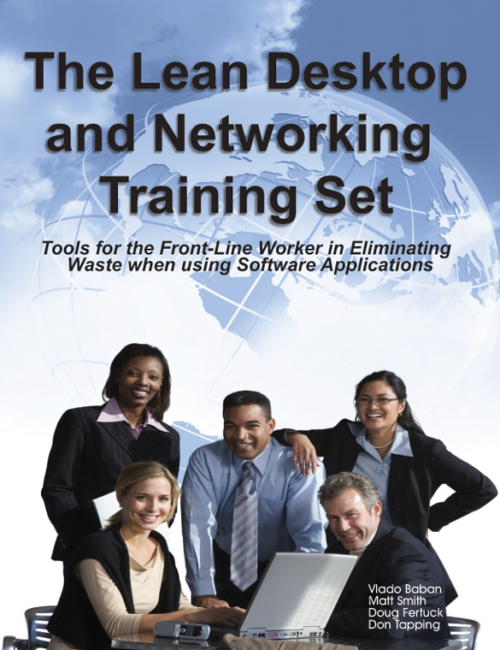 By: Vlado Baban, Doug Fertuck, Matt Smith, Bob Angeli (P.E.), and Don Tapping
By: Vlado Baban, Doug Fertuck, Matt Smith, Bob Angeli (P.E.), and Don Tapping
The Lean Desktop and Networking Pocket Guide XL is designed to be a convenient, quick reference book providing valuable insight into how Lean can be applied to data as it is pulled, analyzed, formatted, and sent through various Desktop and networking applications. The Lean Desktop and Networking Pocket Guide XL details the application of Lean (i.e., the tools and concepts derived from the Toyota Production System), that when leveraged with Microsoft Office and Open Source applications, can assist to better manage data on a daily basis while improving office productivity. Desktop Lean will create a new generation of "power users" and enhance a typical office worker's ability to work individually, as well as collaborate in work group type situations. This "new" power user is a person that readily learns new applications while integrating Lean tools and concepts to eliminate all process waste. -
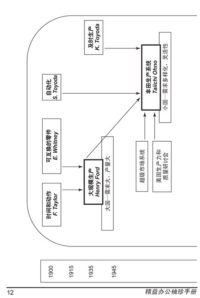
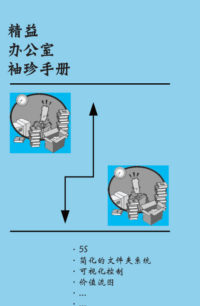 The Lean Office Pocket Handbook (Chinese Edition) is a quick-reference guide covering the terms, concepts, benefits and techniques for the application of Lean in administrative areas of all industry types. It is easy to follow, simple in its concepts, and, above all, practical to use. The tools of 5S, continuous flow, office layout, value stream mapping, process mapping, problem solving, kanbanning office supplies, kaizen, plus numerous other Lean tools are defined in terms that relate to the administrative environment. Paperback - 3.75" x 5.5" - 80 pages
The Lean Office Pocket Handbook (Chinese Edition) is a quick-reference guide covering the terms, concepts, benefits and techniques for the application of Lean in administrative areas of all industry types. It is easy to follow, simple in its concepts, and, above all, practical to use. The tools of 5S, continuous flow, office layout, value stream mapping, process mapping, problem solving, kanbanning office supplies, kaizen, plus numerous other Lean tools are defined in terms that relate to the administrative environment. Paperback - 3.75" x 5.5" - 80 pages

